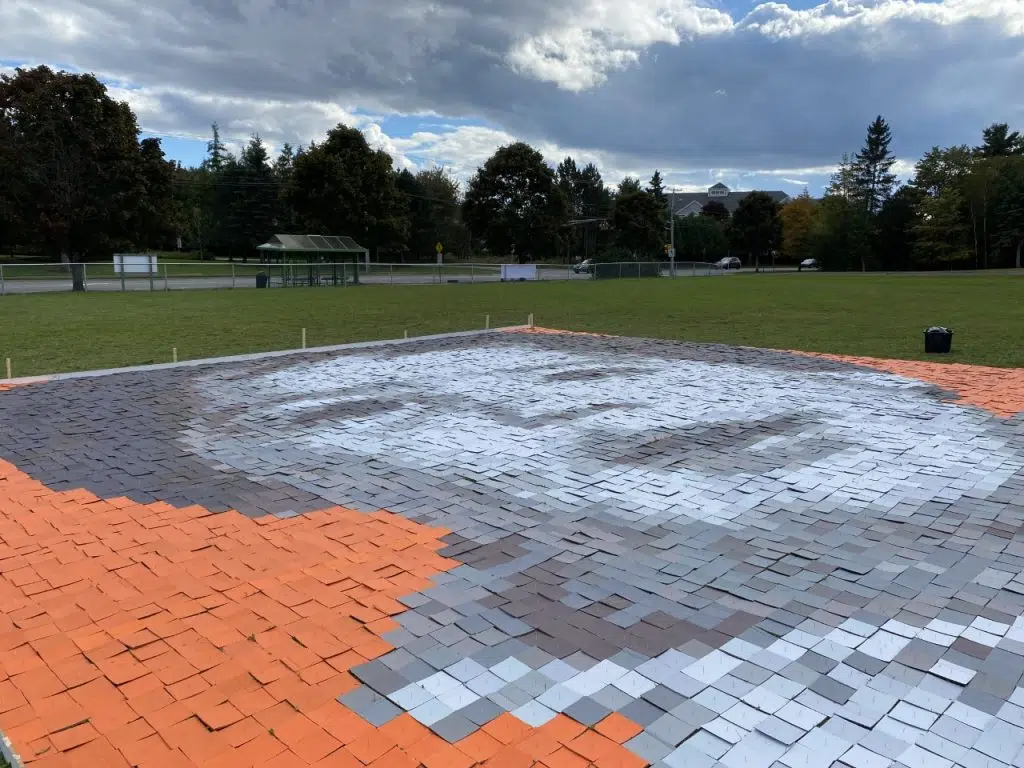The tragic history of the Sixties Scoop was recognized by Rothesay High School students Thursday through a large-scale art installation.
Nearly 8,000 six-inch cardboard squares were placed on the school’s front field to depict a portrait of Sixties Scoop survivor Joanne Munroe as a child.
Munroe’s sister, Minda Burley, was the centre of a similar installation done by Quispamsis Middle School students at the qplex in June.
Meghan Barton, a visual arts teacher at Rothesay High School, said this project was about more than just creating a temporary art installation.
“We wanted everybody to meet Joanne, who was brave enough to come and share her story with 500 people she didn’t know, which is a very powerful thing to do,” said Barton.
“Before the kids met her, we wanted them to have some prior knowledge of what the Sixties Scoop was. A lot of adults don’t know what it is.”
During the Sixties Scoop, about 20,000 Indigenous children were taken from their families and placed in the child welfare system for fostering and adoption. As a result, many of these children were deprived of a connection to their land, culture, and heritage.
Artist Bonny Hill, who is friends with Burley, was asked to help create the initial art installation in Quispamsis recognizing the history of the Sixties Scoop and bringing awareness to the Every Child Matters movement.
Barton, who taught at Quispamsis Middle School last school year, said they were able to reuse the cardboard squares for the latest installation.

An art installation depicting a portrait of Sixties Scoop survivor Joanne Munroe at Rothesay High School on Sept. 29, 2022. Image: Brad Perry
Rothesay High school students spent much of the day Thursday meticulously placing the cardboard squares to create the final portrait, which measured 45 feet by 47 feet.
Among them were Grade 10 students Madeline White, Ashley Parlee, and Brooke Mackin.
White said while she was aware of residential schools, she knew little about the Sixties Scoop until this year. She said it was really emotional to hear about what Munroe went through as a child.
“It’s bittersweet that now she’s finding her family but it’s so terrible that she’s only finding it now,” said White.
Mackin said hearing about the Sixties Scoop from a survivor enhanced their learning about this tragic part of our history.
“I think it’s a great opportunity for students to help with this. It’s something that’s going to bring so much awareness to Joanne,” she said.
Parlee said she hopes the art installation helped more people in the community learn about the Sixties Scoop.
Meanwhile, Barton said she was honoured to be part of such a powerful project.
“Art is not just pretty pictures. It’s about making people go ‘oh wow, I never thought of it that way,'” said Barton.
“We have a systemic issue in this country and this is just a way for us to pull people in, and hopefully they will pause.”
The installation was disassembled on Thursday evening. Barton said the cardboard pieces will now head to Sussex for what will hopefully be the third part of this project.








